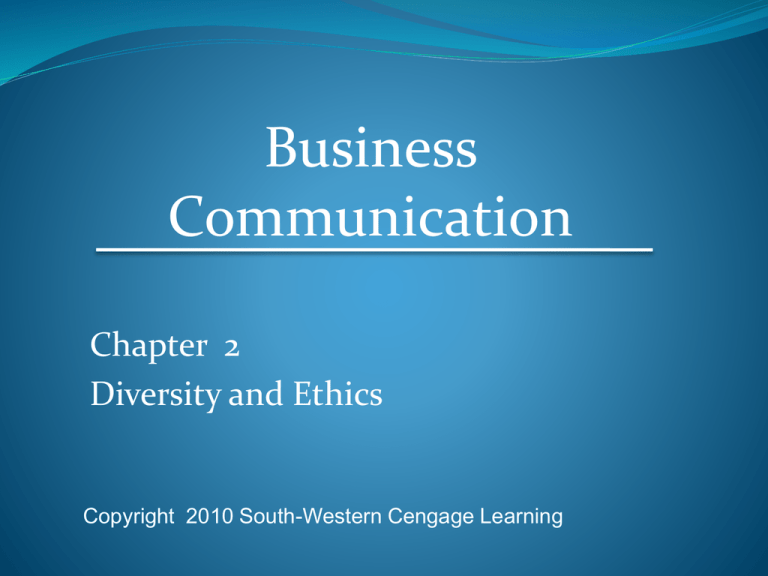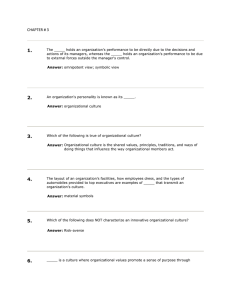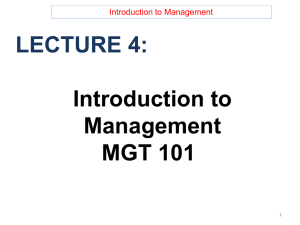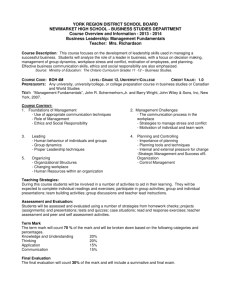Business Communication
advertisement

Business Communication Chapter 2 Diversity and Ethics Copyright 2010 South-Western Cengage Learning Objectives Define diversity and identify its benefits and challenges in the workplace Discuss the diversity of the U.S. population and workforce Discuss how globalization affects the workplace Standard(s) 1.0 - develop and apply concepts related to human relations, safety, career development, communications and leadership skills for a global workplace 2 Overview of Diversity Diversity benefits Diversity challenges Diversity trends Diversity Terms © Digital Vision / Getty Images A diverse workforce can help a company understand its customers. 2.1 Diversity at Work 3 Diversity Benefits Having a diverse workforce Enhances the reputation of the company Helps company attract talented employees and keep customers Can help a company understand its customers’ needs Diverse workgroups may be more creative and innovative 4 Diversity Challenges Lack of attention to diversity issues can be costly Possibly lose employees who believe that their employer is indifferent or hostile to people “like them” May not understand their customers’ needs/wants 5 Diversity Trends Population predictions U.S. population projected to reach 419.9 million in 2050 U.S. population will become more diverse Hispanic and Asian populations will triple over the next half century Caucasians will soon be the MINORITY! By 2030, about 1 in 5 people will be 65 or older Diverse workforce Workforce will increase to 162.3 million by THIS YEAR Women will make up close to half the labor force 2.1 Diversity at Work 6 The World as a Global Workplace Globalization: the integration of activities among nations in areas such as commerce and culture Globalization and the workforce Competing with candidates from around the world Harder to get a job Multinational companies Conducts business w/ at least 2 nations PepsiCo is available in nearly 200 countries © Beathan / Corbis Globalization affects the workforce in many ways. 2.1 Diversity at Work 7 Work/Life Balance Work/life balance: the need workers have to balance work with other aspects of life Different careers make different demands on workers and their families Consider how your career choice will affect all aspects of your life 2.1 Diversity at Work 8 Quick Review What are some benefits of having a diverse workforce? Is the U.S. workforce as a whole getting younger or older? How can globalization affect people who are looking for jobs? 9 2.1 Assignment Grab a Business Communications textbook (author THOMAS MEANS) Turn to page 39 Complete Part B – Diversity in Your State Use this website: www.cengage.com/school/bcomm/buscomm Select a Chapter: Chapter 2 Web Links USA Quick Facts Turn in when finished! 10 11 Objectives Describe examples of differences among cultures Explain the importance of respecting customs and practicing etiquette Standard(s) 1.0 - develop and apply concepts related to human relations, safety, career development, communications and leadership skills for a global workplace 12 Cultural Differences Language Body language Personal space © Stockbyte / Getty Images Greeting colleagues appropriately is important. 2.2 Differences 13 Language Most common communication barrier In the 2000 U.S. Census, nearly 11 million people indicated that they did not speak English well or at all! Don’t forget that even people from different states in our country have different accents that make it difficult to understand 14 Body Language The facial expressions, gestures, or postures that accompany a person’s words often have GREATER meaning than the words themselves The less people understand English, the more they rely on body language 15 Body Language Gestures are NOT the same everywhere! The “okay” symbol means worthless or zero in France Elsewhere, it is considered obscene In the US, eye contact while talking is GREAT! In many other cultures, less eye contact is more respectful Many countries and religions consider feet to be unclean Do not cross your feet at the ankles, it shows the soles of your feet, which is considered rude If you touch someone with your feet, apologize! Personal Space Most Americans appreciate personal space of 18 inches to 4 feet This of course varies for different cultures Being in someone’s personal space may make some people uncomfortable When American’s step back to create more space, in some cultures, this is offensive Customs and Etiquette Customs: beliefs, traditions, and practices of a group of people Etiquette: a set of rules of behavior for a particular place or situation Customs and etiquette vary from culture to culture Stereotype – certain belief about a group of people Leads to judging people as members of a group rather than individuals Prejudice – bias that prevents objective thought about a person or thing Can hinder communication 2.2 Differences 18 Quick Review Name 2 differences in culture that may be barriers to communication. How can a stereotype and prejudice hinder communication? 19 20 Objectives Describe traits and actions that indicate a person has a professional attitude Describe strategies for speaking and corresponding successfully with people from other cultures Standard(s) 1.0 - develop and apply concepts related to human relations, safety, career development, communications and leadership skills for a global workplace Professional Attitude Reduces communication barriers A person who has a professional attitude: Refrains from making judgments about others Keeps an open mind Does not make assumptions or jump to conclusions Keeps emotions in check Is slow to take offense Gives others the benefit of the doubt 2.3 Strategies for Effective Communication 22 Professional Attitude Not being offended easily is one of the MOST IMPORTANT aspects of having a professional attitude If a coworker says something that sounds offensive, stop and think. Was the offense intentional? Did you understand the remark correctly? How often has someone interpreted something you said differently than you intended? Is it possible that could be the case here, too? 23 Cross-Cultural Communication When people from different cultures share messages Guidelines Learning Language Cross-Cultural Guidelines © Digital Vision / Getty Images When language is a barrier, use visual aids that are easily understood. 2.3 Strategies for Effective Communication 24 Learning When working with people from other cultures, spend time learning about those cultures Use internet sources, read books/magazines, and see foreign movies Visit ethnic neighborhoods Enroll in diversity training 25 Language Language is the first barrier to cross-cultural communication Some companies offer foreign language courses for employees If nothing else, learn how to: greet someone, say goodbye, say please and thank you. This can open the door to good relationships with people from other cultures 26 Fairness and Sensitivity Have a professional attitude Treat everyone with respect Do not discriminate unfairly © Photodisc / Getty Images Avoid sensitive topics when talking with clients. 2.3 Strategies for Effective Communication 27 Fairness and Sensitivity Do not say: the Vietnamese patient in Room 122 Say: the patient in Room 122 Do not say: Steve is a male nurse Say: Steve is a nurse Do not say: the bagger with Down’s syndrome Say: the bagger at Register 4 28 Quick Review What traits and actions indicate that a person has a professional attitude? What methods can you use to learn about other cultures? 29 EEOC EEOC: U.S. Equal Employment Opportunity Commission Questions 1. List the links that are shown under Discrimination by Type. 2. Click one of the links and read the page. TYPE a paragraph of the main points of the page that you have chosen. Save this document in YOUR DOCUMENTS! http://www.eeoc.gov/laws/types/index.cfm 2.3 Strategies for Effective Communication 30 2.3 Assignment Business Communication Textbook (MEANS) Page 51 Parts A, B, C (TYPE) Save under YOUR DOCUMENTS! After you save, right click in the My Documents folder and click COPY In order to TURN IN both assignments: Student Apps Assignment turn in Rochelle Find YOUR NAME Open folder and right click and click PASTE 31 32 Objectives Define ethics Identify ethical issues related to communication Apply ethical standards to business communication Standard(s) 1.0 - develop and apply concepts related to human relations, safety, career development, communications and leadership skills for a global workplace Ethics in Business Communication Ethics: principles of right and wrong Personal ethics are influenced by: Your experiences Your culture Code of ethics: statement of how a business or group should treat clients, employees, or members 2.4 Ethics in Business Communication 34 Communicating in an Ethical Way Honesty Confidential information Medical information Protected by law Can’t share w/o written consent Other types of information Identity theft © Photodisc / Getty Images Trade secrets Be truthful when communicating Gives a business a competitive with customers. advantage These are both CRIMES 2.4 Ethics in Business Communication 35 Communicating in an Ethical Way Protecting confidential data Understand your company’s policies Privacy and electronic rights Protect data stored on computers Keep passwords SECURE – see handout Remember that e-mail and text messages are not private 2.4 Ethics in Business Communication 36 Communicating in an Ethical Way Plagiarism Avoiding plagiarism – source anything you may use Copyright and fair use Copyright ©– the legal right of someone, usually the author or artist, to use or reproduce a work During the time of the copyright, if you wish to quote something from a book, you must obtain WRITTEN permission from the author Fair use – allows limited use of copyrighted material without the author’s permission Cannot profit from use 37 Quick Review What factors influence personal ethics? List four types of information that are often confidential. Should you make a comment in an e-mail or instant message that you would not put in a printed letter? Why or why not? How can you avoid plagiarism? 38 Project Time!! See handout 39 Cross-Cultural Communication Guidelines Do not make assumptions Be adaptable Avoid discussing sensitive topics Be careful when using humor Maintain personal contact Listen actively Use visual aids BACK 2.3 Strategies for Effective Communication 40 Terms Related to Diversity Race The division of people into groups based on physical characteristics, such as skin or hair color Ethnicity The division of people into groups that share a common ancestry, history, or culture Culture A set of beliefs, attitudes, practices, and social customs that distinguishes a group of people Inclusion Seeing and valuing the contributions of everyone in a workplace and treating everyone fairly BACK 2.1 Diversity at Work 41






